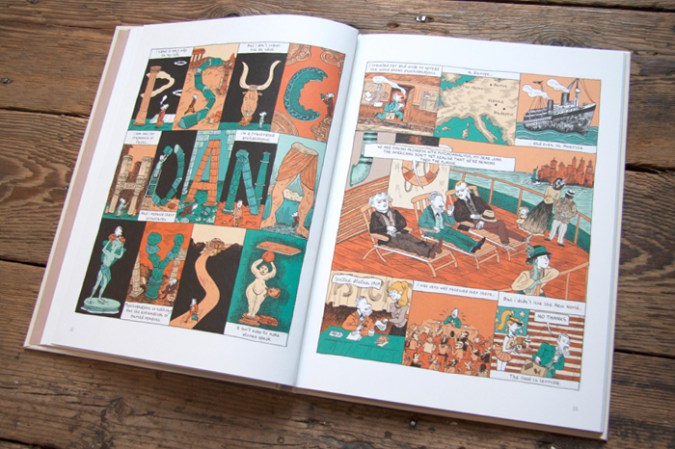Einstein, Freud, and Marx: Nobrow Graphic Biographies

Corinne Maier writes and Anne Simon illustrates these three graphic biographies of notable figures whose thinking changed the world. They’re handsome European-style hardcovers, allowing for pages packed with detail, putting readers in the day-to-day moments as well as capturing the major discoveries.
Those accomplishments become part of the flow, which is more realistic, as people rarely realize the significance of a discovery when it happens. Maier gives as much space to domestic concerns, providing a full portrait of the subject’s life, not just their thoughts.
Simon’s style is welcoming, a bit wiggly as though drawing a caricature, which allows for emotional reaction while capturing the essence of the likeness. Many of the pages are 12-panel grids, but she opens up the page when it comes to a particular theory or important moment. Even the smaller panels vary between conversation and cleverly chosen images to set the right understanding of setting and period.
Einstein, the most recent release, covers the life of Albert Einstein, whose theory of relativity revolutionized modern physics. He started as a poor student, albeit one with astounding curiosity. He was brilliant when he was allowed to do what he wanted, and when he wasn’t distracted by women. (One of whom was named Johanna!)
I enjoyed the way Einstein’s failings were shown, as well as his successes. He was a thoughtless partner and father, too wrapped up in his life of the mind while ignoring that his first wife, also a physicist, might have liked the same freedom. He regretted what his thought experiments eventually led to, the atomic bomb, which led to his later struggles with politics, speaking for peace.
Maier incorporates the context of the times, whether sexism or anti-semitism or nationalism, and places Einstein in the greater context of 20th century deconstructionism. He searches to find a place to fit in, moving from Germany to Italy to Switzerland to America. He struggles with Judaism, being anti-religious but recognizing the cultural importance. As a result, to the reader, he becomes a personality, not just a famous person.
Freud takes a similar approach for the “founding father of psychoanalysis”. Sigmund Freud develops a talking cure, begins to puzzle out the meanings of dreams, and insists everything is, at root, about sex. These explorations of the unconscious allow for Simon to create some fascinating full-page montages, full of symbolism, including one impressive combination of antiques formed into letters.
Interpreting the layouts can be similar to working out neuroses through discussion. This volume is less about a straightforward telling of Freud’s life, more about treating his famous ideas and cases playfully, making the ideas memorable, particularly the underlying concept of repressed desire that transformed the modern cultural era.
Marx demonstrates Karl’s path through law, philosophy, journalism, Germany, France, Belgium, and England on his way to encouraging anti-capitalist revolution with The Communist Manifesto.
It can be enlightening seeing what influences directed him, since his ideas have been so culturally maligned to modern readers. As a product of a different time, his philosophies stemmed from his poverty, when that meant something much worse than it does now. The problem of “too many goods, not enough customers” (because not enough income) is particularly relevant today. Yet we also see Marx failing at getting a job, relying instead on inheritances, and spending money to move into nicer homes and send his children to private school. Money is all about hypocrisy.
Reading all three volumes close to each other brings out the important contributions made by German Jews of a certain era, in spite of the challenges they faced with their culture and country. (The publisher provided review copies.)




2 comments